Stem cell banking is becoming increasingly important for the research and development of preventative strategies and therapies for several diseases. For decades, stem cell research has evoked heated debate surrounding the ethics of collecting pluripotent stem cells, those which can differentiate into any kind of cell, from embryos.

Image Credit: Elena Pavlovich/Shutterstock.com
To overcome the ethics of pluripotent stem cell research, scientists have begun to focus on collecting and researching adult stem cells that can be collected less invasively from cord blood, skin, bone marrow, and milk teeth. The cells are more restricted as to what they can differentiate into, they can produce all types of blood cells and are, therefore, vital to developing new treatments for spinal cord injury, cardiovascular and autoimmune disease.
Here, we discuss the most common ways of obtaining stem cells for stem cell banking, where cells are collected, processed, and stored for use in medicine and research. Additionally, we look into the various uses stem cells have in medicine.
Stem cell banking from cord blood
Cord blood is the blood that is contained in the placenta and umbilical cord and is rich in stem cells. After the baby has been born, stem cells can be extracted from the blood that remains in these biological tissues.
In many cord blood banks, small blood bags are used to store collections of cord blood, which is collected after the birth and before the delivery of the placenta via accessing the umbilical vein.
Red blood cells are the major component of cord blood, followed by neutrophils, which account for around 70 to 80% of the leukocyte population. However, it is the mononuclear fraction, accounting for 20% of the leukocyte population that needs to be banked as it is the fraction that contains the stem cell population.
Usually, around 70 to 80ml of cord blood is banked from full-term live births.
Stem cell banking from cord tissue
While cord blood is the primary source used of stem cells that can be obtained at birth, cord tissue offers an additional supply of mesenchymal stem cells. In banking cord tissue, scientists ensure a source of stem cells for future research into regenerative medicine and tissue engineering. Additionally, cord tissue is also abundant in endothelial and epithelial precursor cells, which may also be useful for medical research.
While mesenchymal stem cells can be obtained from either cord blood or cord tissue, reports have highlighted difficulties in isolating such cells directly from cord blood, which makes the case for obtaining mesenchymal stem cells from cord tissue.
Stem cell banking from adipose tissue
Adipose tissue offers a different source of stem cells. In comparison to cord blood and tissue, adipose tissue is not obtained at birth. Adipose (fat) tissue is most often obtained during liposuction procedures, with the consent of the patient.

Image Credit: Yurchanka Siarhei/Shutterstock.com
Uses of stem cells
Research projects utilizing adult stem cells have the potential to produce life-saving therapies and groundbreaking regenerative medicine.
For more than two decades, stem cells obtained from cord blood have been used to treat both malignant and genetic blood disorders. In more recent years, cord blood has been increasingly used in clinical trials investigating potential new regenerative medicines.
Even more recently, research utilizing cord tissue stem cells has begun to emerge. Over the last few years, a number of studies have been published that demonstrate the vast potential of using cord tissue in research and clinical trials in the investigation of new treatments for a wide range of diseases. Recently, data emerged demonstrating the use of mesenchymal stem cells obtained from cord tissue in patients with non-healing bone fractures.
One study, in particular, has demonstrated positive results following the intravenous infusion of cord tissue-derived mesenchymal stem cells in treating graft versus host disease (GVHD) following hematopoietic stem cell transplantation.
Cord tissue mesenchymal stem cells have also been shown to have therapeutic benefits in autoimmune diseases. Recent research has reported these stem cells stabilizing the disease course of multiple sclerosis (MS) in a patient who was not responding to conventional treatment options. Another case report has also reported similar improvements in a patient with systemic lupus erythematosus following intravenous infusion of cord tissue mesenchymal stem cells.
Stem cells obtained from various forms of stem cell banking will likely become increasingly useful in years to come. Currently, numerous studies and either planned or underway using banked stem cells to develop treatments for diseases and conditions including autoimmune diseases (such as type I diabetes and MS) and cardiovascular diseases (such as critical limb ischemia, heart attack, and stroke). Additionally, studies are underway exploring the use of stem cells in orthopedic applications (including bone fractures, cartilage injuries, osteoarthritis, osteogenesis imperfecta) and transplantation of organs.
In the coming years, we can expect a greater emphasis to be put on stem cell banking, with more facilities opening up as more evidence is collected to show the potential therapeutic value of stem cells.
Read more on stem cells here.
Sources:
- Harris, D., 2014. Stem Cell Banking for Regenerative and Personalized Medicine. Biomedicines, 2(1), pp.50-79. https://www.ncbi.nlm.nih.gov/pmc/articles/PMC5423479/
- Liang, J., Zhang, H., Hua, B., Wang, H., Wang, J., Han, Z. and Sun, L., 2009. Allogeneic mesenchymal stem cells transplantation in treatment of multiple sclerosis. Multiple Sclerosis Journal, 15(5), pp.644-646. https://journals.sagepub.com/doi/abs/10.1177/1352458509104590
- Wu, K., Chan, C., Tsai, C., Chang, Y., Sieber, M., Chiu, T., Ho, M., Peng, C., Wu, H. and Huang, J., 2011. Effective Treatment of Severe Steroid-Resistant Acute Graft-Versus-Host Disease With Umbilical Cord-Derived Mesenchymal Stem Cells. Transplantation, 91(12), pp.1412-1416. journals.lww.com/.../..._Treatment_of_Severe_Steroid_Resistant.19.aspx
Further Reading